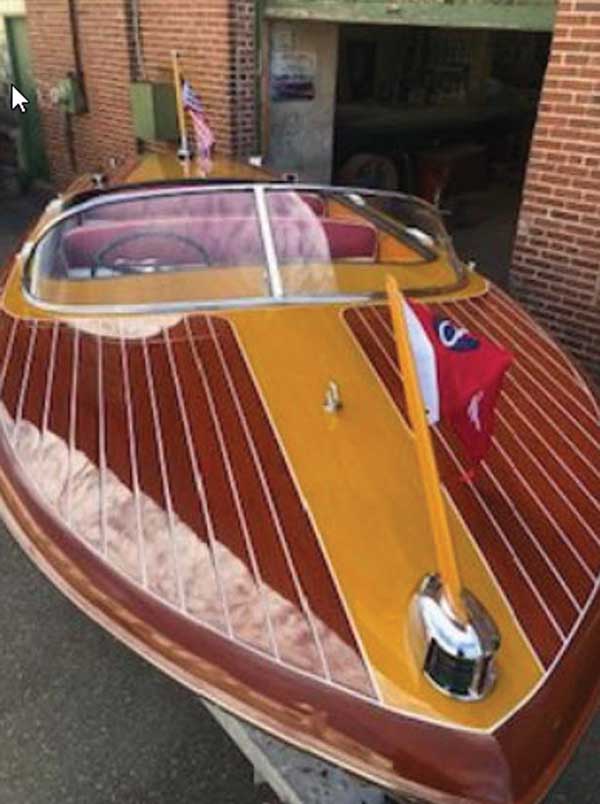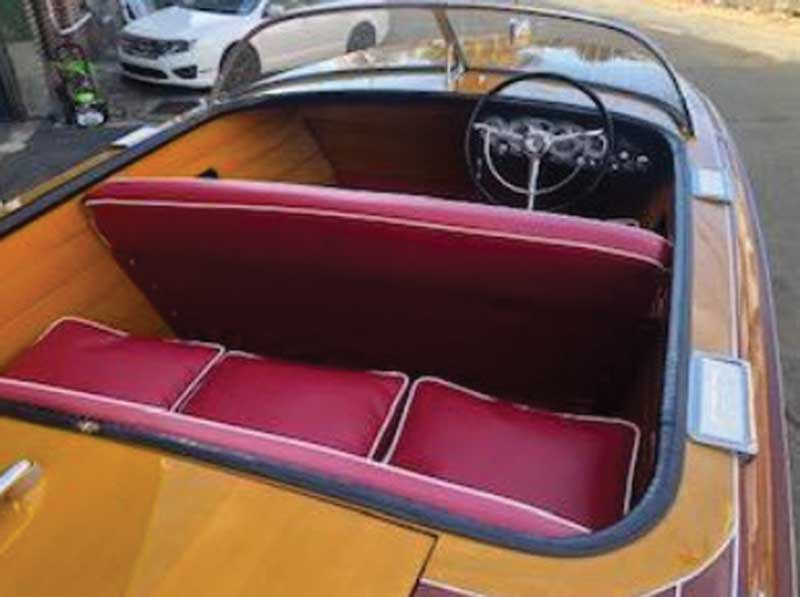The Chris-Craft Capri model was built from 1955 to 1958. They produced 786 of these boats during that period. This particular 19-foot wood boat was produced during the 1956 model year.

Although Chris-Craft referred to this model as a 19-footer, it was actually 18 feet, seven inches in length, with a beam of six feet, three inches. The freeboard is 31 inches at the bow and 20 inches at the stern. She weighs about 2200 pounds and has an in-line, six-cylinder engine. The gas tank capacity is 20 gallons. She is an all-mahogany planked boat, although her framing and the keel are made from oak.
Chad Brenner (a long-time member of the Antique and Classic Boat Society (ACBS) Mid-Atlantic chapter) and his Philadelphia-based crew at Classic Restoration and Supply/Vintage Craft Boats performed a top-notch, full restoration of this classic. Brenner also builds classic boats at the same business location “from the ground up” that are typically replicas of historic craft. These photos illustrate the showboat quality of the work his team delivers.
In this Capri’s restoration process, the entire original hull and all of the deck planks were removed. New battens were fashioned to fit between the planks and then the planks were reinstalled and refinished. Last but not least, all of the hardware was refinished, and all the upholstery was replaced.

Meanwhile, Joe Gartner on Chad’s crew rebuilt the carburetor so it would run well at the complete range of engine speeds. Joe also detailed the engine and rewired the boat.
Let’s take a closer look now at the structure Chris-Craft used to build its runabouts. Batten seam construction means that each plank has a smaller piece (the “batten”) that backs up each plank seam along the full length of the boat. So, the planks are fastened not only to the boat’s frames but also to the battens. The only exception to this process in the Chris-Craft line of runabouts was the Cavalier series, which used plywood instead of individual wood planks in their construction.
The batten seam method offered a lot of other advantages, too.
Batten construction is extremely strong and still relatively light compared to double plank boats. So, it enabled single planked boats to be built with thinner planks.
It was the preferred construction for runabouts in cold climates since those boats are typically out of the water for so long. The seams on a carvel-planked boat can dry up and open wider between planks when the boat is out of the water.
The durability of Chris-Craft’s technique with batten-seam construction and long-term endurance was a winning solution. Although the boats were often the price leader compared to other brands, Chris-Craft’s offerings were also the most popular of the wooden boat builders. As a result, Chris-Craft achieved a great deal of success and was the leader in production volume among all wooden boat builders for many years.

In 1926, A.W. (Bill) Mackerer joined the company and soon became Chris-Craft’s top designer, yet he was also in charge of being frugal to ensure that the company made a profit. He was highly regarded since he had studied and/or worked under some of the best designers, including John L. Hacker, George Crouch, and Gil Purdy.
Laying out their new manufacturing process in a new building while following the style of Henry Ford and others, the Smiths launched what would become an empire by building boats that streamlined the production line and drove down prices.
Chris-Craft was the most popular boat builder in the 1950s, and the Capri was among their most popular models. The company was very much a leader within the wooden boat building industry and operated several plants to accomplish this.
Chris Smith’s family later sold the company to the NAFI Corporation in 1960. NAFI actually changed its company name in 1962 to Chris-Craft. Fast-forward 26 years later, under new ownership, the company was losing an estimated two million dollars each month by the second half of 1988. Their financial situation was so bleak by the end of 1988 that Chris-Craft filed for bankruptcy.
Since then, there have been a series of owners. Winnebago Industries (the RV manufacturer) has been Chris-Craft’s owner since 2018.
By Chris "Seabuddy" Brown